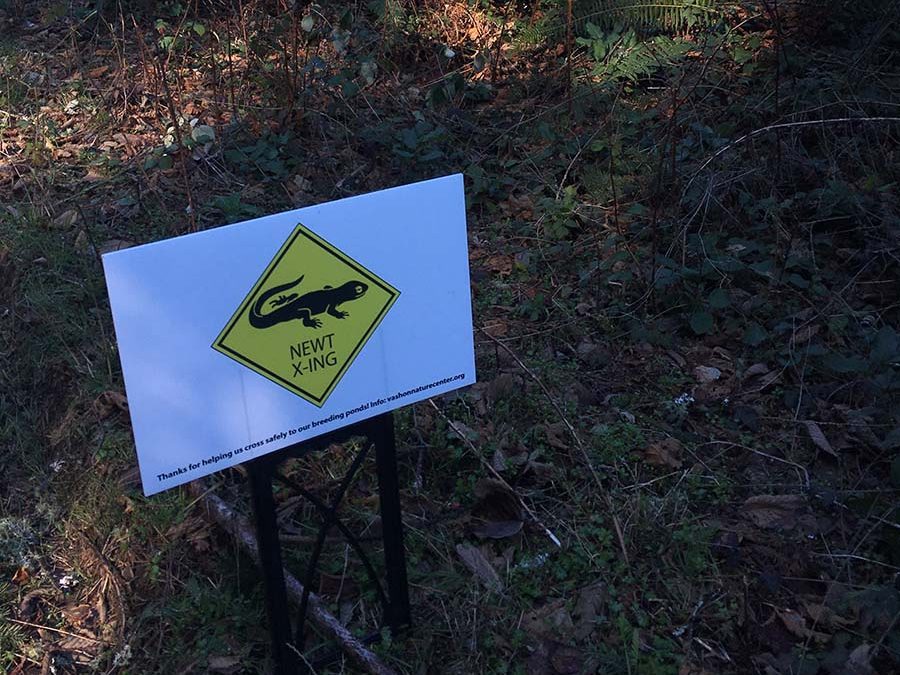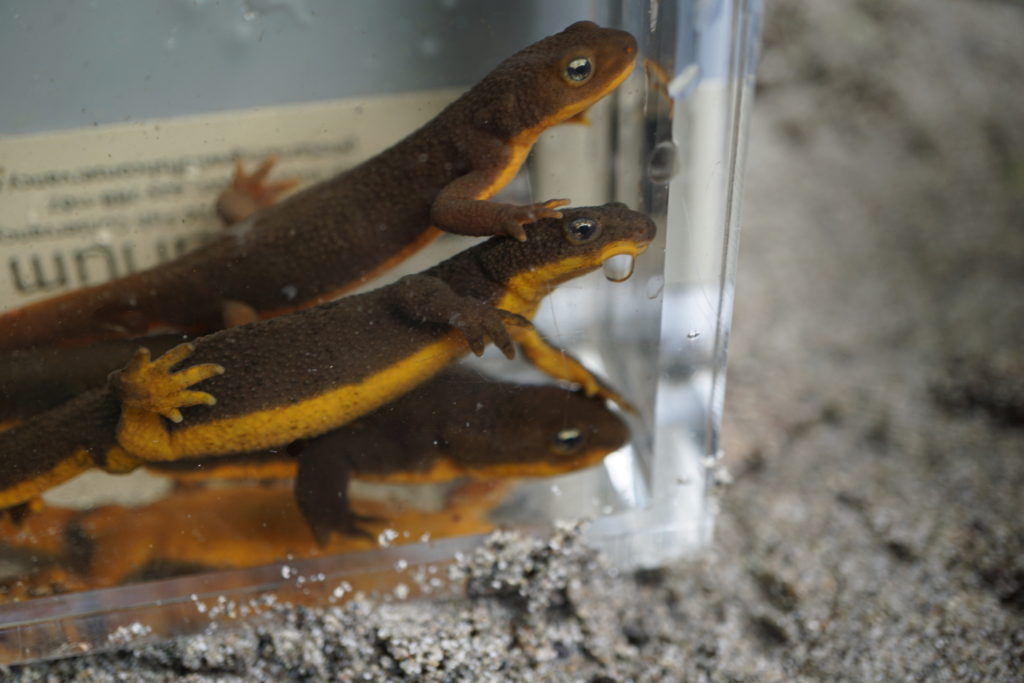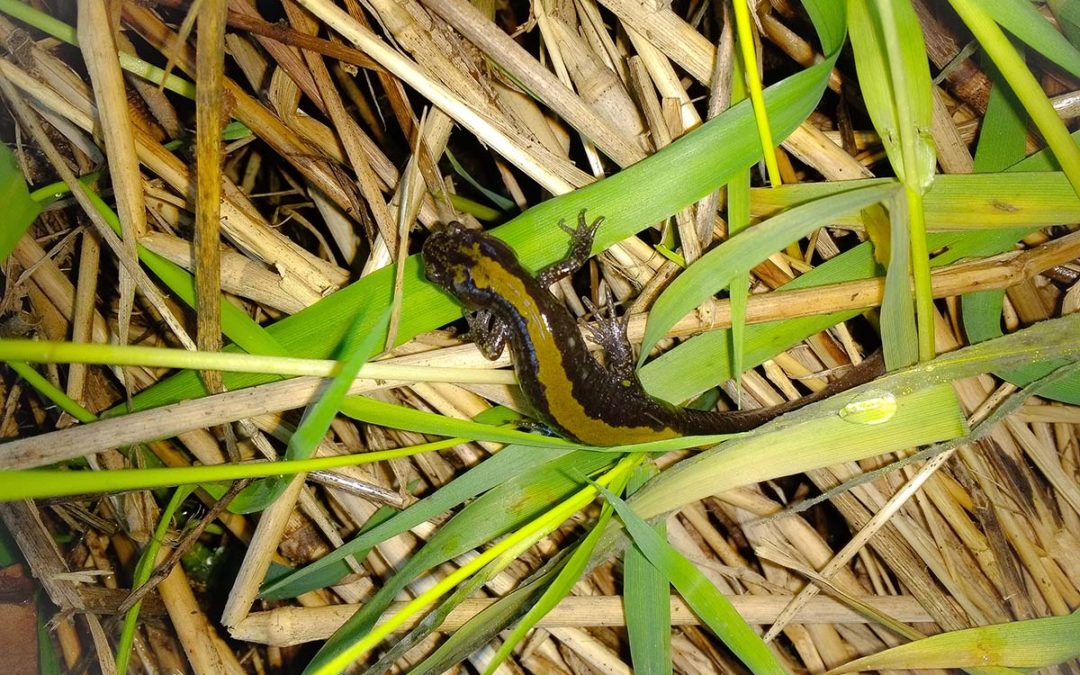Grab a flashlight and take a walk to one of Vashon’s ponds or wetlands tonight and you may encounter some of nature’s valentines. Mid-February is prime salamander mating season on Vashon. Look for wriggling pairs or groups of both Northwestern and long-toed salamanders under leafy debris in the shallows.
These two species of native salamander (Ambystoma gracile and A. macrodactylum) are part of a group known as mole salamanders because they spend the (mainly) terrestrially portion of their lives huddled under logs or in shallow rodent burrows in our forests. No one knows the exact cues they use to start mating, but air temperature and the length of daylight likely play a role.
This Northwestern salamander (A. gracile) egg cluster was found in a survey by at Christensen Pond. Photo by: Bianca Perla
After mating, females lay eggs and attach them to submerged vegetation. The Northwestern salamanders form grapefruit-sized clumps of eggs, which become covered with a thin film of algae that provides oxygen to the growing embryos. Long-toed salamander egg clusters are smaller than those of the Northwesterns and are usually attached to submerged sticks.
Salamander Mermaids
When salamander larvae emerge from their eggs, they look like tadpoles with feathery gills protruding from the sides of their heads. Generally, these larvae transform into adults and leave their natal ponds by the end of summer. They reach sexual maturity in 1 to 2 years and return to their breeding ponds only during mating season. However, some salamanders do not transform—instead, they sprout legs and grow to adult size while retaining gills. These salamander “mermaids and mermen” remain in their “water body” their entire lives and breed in this form as well. Reaching sexual maturity in the larval stage is called neotony.
On your wetland wander, you may also hear or see red-legged frogs (Rana aurora) or Pacific treefrogs (Hyla regilla). Islanders have reported hearing the first rounds of the treefrogs’ annual chorus, which signifies the start of their breeding season. Pacific treefrogs (aka peepers) have a very recognizable song, whereas the red-leggeds’ low raspy call is rarely heard.

Rough-skinned newts
Mole salamanders are less conspicuous than rough-skinned newts (Taricha granulosa), which also procreate in our local ponds. They usually wait until it is a bit warmer before marching back to the ponds of their youth; their breeding season peaks in March or April. After mating, rough-skinned newts attach single eggs to submerged vegetation.
Rough-skinned newts are brown with bright-orange underbellies. This conspicuous color announces to would-be predators: “Harmful! Do not eat!” Newt skin carries a neurotoxin, so wash your hands thoroughly if you touch one to avoid accidentally ingesting this toxin. Only garter snakes can stomach rough-skinned newts and, with few predators, they can safely migrate to breeding ponds in broad daylight (while mole salamanders wait for the cover of darkness).

Find amphibians on Vashon
With the potential for the first warm rains of the year, this Valentines Day evening could be especially good for sightings. Good places to look are Christensen Pond and Lost Lake, which was originally dubbed Lizard Lake in the early 1900s by neighborhood children because its wealth of salamanders and newts. Other likely spots include Fisher Pond, the wet ditches along Bank Road near Fisher Pond, the Chautauqua Elementary School ponds, and Mukai Pond in Island Center Forest. Any small ponds or ephemerally wet ditches or meadows are potential breeding areas for island salamanders and frogs.
If you do find mating salamanders, let us know. Native amphibians seem to be in a general decline on Vashon, probably due to a variety of environmental factors including development, hazardous road crossings and climate change. We’d like to get a better handle on where they are thriving, so send photos and reports to: info@vashonnaturecenter.org.
A recommended book for further exploration: Amphibians of Oregon, Washington and British Columbia: A Field Identification Guide by Charlotte Corkran and Chris Thoms.
This is an updated version of a VNC blog post from 2013.

